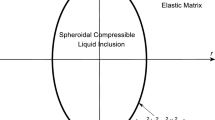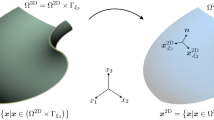Abstract
A finite element analysis of frictionless indentation of an elastic-plastic half-space by a rigid sphere is presented and the deformation behavior during loading and unloading is examined in terms of the interference and elastic—plastic material properties. The analysis yields dimensionless constitutive relationships for the normal load, contact area, and mean contact pressure during loading for a wide range of material properties and interference ranging from the inception of yielding to the initiation of fully plastic deformation. The boundaries between elastic, elastic-plastic, and fully plastic deformation regimes are determined in terms of the interference, mean contact pressure, and reduced elastic modulus-to-yield strength ratio. Relationships for the hardness and associated interference versus elastic-plastic material properties and truncated contact radius are introduced, and the shape of the plastic zone and maximum equivalent plastic strain are interpreted in light of finite element results. The unloading response is examined to evaluate the validity of basic assumptions in traditional indentation approaches used to measure the hardness and reduced elastic modulus of materials. It is shown that knowledge of the deformation behavior under both loading and unloading conditions is essential for accurate determination of the true hardness and reduced elastic modulus. An iterative approach for determining the reduced elastic modulus, yield strength, and hardness from indentation experiments and finite element solutions is proposed as an alternative to the traditional method.
Similar content being viewed by others
References
L. Vu-Quoc, X. Zhang, and L. Lesburg: A normal forcedisplacement model for contacting spheres accounting for plastic deformation: Force-driven formulation. J. Appl. Mech. 67, 363 (2000).
K. Komvopoulos and N. Ye: Three-dimensional contact analysis of elastic–plastic layered media with fractal surface topographies. J. Tribol. 123, 632 (2001).
K. Komvopoulos and W. Yan: Three-dimensional elastic–plastic fractal analysis of surface adhesion in microelectromechanical systems. J. Tribol. 120, 808 (1998).
W.R. Chang, I. Etsion, and D.B. Bogy: Static friction coefficient model for metallic rough surfaces. J. Tribol. 110, 57 (1988).
P. Sahoo and S.K. Roy Chowdhury: A fractal analysis of adhesive friction between rough solids in gentle sliding. Proc. Inst. Mech. Engrs. J. 214, 583 (2000).
B. Bhushan: Contact mechanics of rough surfaces in tribology: Single asperity contact. J. Appl. Mech. Rev. 49, 275 (1996).
B. Bhushan: Contact mechanics of rough surfaces in tribology: Multiple asperity contact. Tribol. Lett. 4, 1 (1998).
G. Liu, Q. Wang, and C. Lin: A survey of current models for simulating the contact between rough surfaces. Tribol. Trans. 42, 581 (1999).
G.G. Adams and M. Nosonovsky: Contact modeling–Forces. Tribol. Int. 33, 431 (2000).
D. Tabor: The Hardness of Metals (Clarendon Press, Oxford, U.K., 1951).
E.G. Herbert, G.M. Pharr, W.C. Oliver, B.N. Lucas, and J.L. Hay: On the measurement of stress-strain curves by spherical indentation. Thin Solid Films 398–399, 331 (2001).
N. Huber, A. Konstantinidis, and C. Tsakmakis: Determination of Poisson’s ratio by spherical indentation using neural networks–Part I: Theory. J. Appl. Mech. 68, 218 (2001).
A. Nayebi, R. El Abdi, O. Bartier, and G. Mauvoisin: New procedure to determine steel mechanical parameters from the spherical indentation technique. Mech. Mater. 34, 243 (2002).
W.C. Oliver and G.M. Pharr: An improved technique for determining hardness and elastic modulus using load and displacement sensing indentation experiments. J. Mater. Res. 7, 1564 (1992).
K.L. Johnson: Contact Mechanics (Cambridge University Press, Cambridge, U.K., 1985), pp. 90–95 and 170–184.
R. Hill, B. Storåkers, and A.B. Zdunek: A theoretical study of the Brinell hardness test. Proc. R. Soc., London Ser. A 423, 301 (1989).
S. Biwa and B. Storåkers: An analysis of fully plastic Brinell indentation. J. Mech. Phys. Solids 43, 1303 (1995).
A.C. Fischer-Cripps: Elastic–plastic behavior in materials loaded with a spherical indenter. J. Mater. Sci. 32, 727 (1997).
C. Hardy, C.N. Baronet, and G.V. Tordion: The elasto-plastic indentation of a half-space by a rigid sphere. Int. J. Numer. Meth. Eng. 3, 451 (1971).
P.S. Follansbee and G.B. Sinclair: Quasi-static normal indentation of an elasto-plastic half-space by a rigid sphere. Part 1: Analysis. Int. J. Solids Struct. 20, 81 (1984).
E.R. Kral, K. Komvopoulos, and D.B. Bogy: Elastic–plastic finite element analysis of repeated indentation of a half-space by a rigid sphere. J. Appl. Mech. 60, 829 (1993).
A.E. Giannakopoulos: Strength analysis of spherical indentation of piezoelectric materials. J. Appl. Mech. 67, 409 (2000).
S. Kucharski and Z. Mroz: Identification of plastic hardening parameters of metals from spherical indentation tests. Mater. Sci. Eng. A 318, 65 (2001).
S.D. Mesarovic and N.A. Fleck: Spherical indentation of elastic–plastic solids. Proc. R. Soc., London Ser. A 455, 2707 (1999).
N. Ye and K. Komvopoulos: Indentation analysis of elastic–plastic homogeneous and layered media: Criteria for determining the real material hardness. J. Tribol. 125, 685 (2003).
K.L. Johnson: Correlation of indentation experiments. J. Mech. Phys. Solids 18, 115 (1970).
I.N. Sneddon: The relation between load and penetration in the axisymmetric Boussinesq problem for a punch of arbitrary profile. Int. J. Eng. Sci. 3, 47 (1965).
J. Thurn, D.J. Morris, and R.F. Cook: Depth-sensing indentation at macroscopic dimensions. J. Mater. Res. 17, 2679 (2002).
D.M. Marsh: Plastic flow in glass. Proc. R. Soc., London Ser. A 279, 420 (1964).
M.M. Chaudhri: Strain hardening around spherical indentations. Phys. Status Solidi A 182, 641 (2000).
S.D. Mesarovic and K.L. Johnson: Adhesive contact of elastic–plastic spheres. J. Mech. Phys. Solids 48, 2009 (2000).
Y.J. Park and G.M. Pharr: Nanoindentation with spherical indenters: Finite element studies of deformation in the elastic–plastic transition regime. Thin Solid Films 447, 246 (2004).
Author information
Authors and Affiliations
Rights and permissions
About this article
Cite this article
Kogut, L., Komvopoulos, K. Analysis of the spherical indentation cycle for elastic-perfectly plastic solids. Journal of Materials Research 19, 3641–3653 (2004). https://doi.org/10.1557/JMR.2004.0468
Received:
Accepted:
Published:
Issue Date:
DOI: https://doi.org/10.1557/JMR.2004.0468




